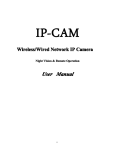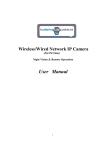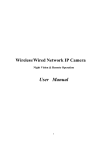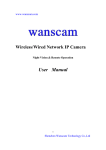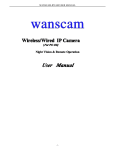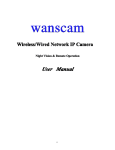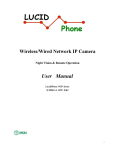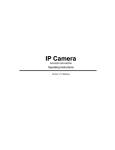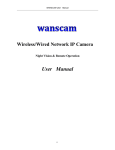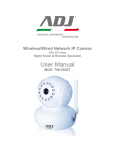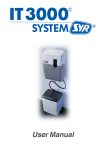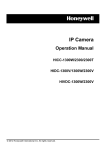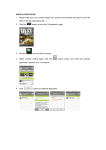Download I11123BK Manual
Transcript
IPCAM User Manual Wireless/Wired Network Camera Night Vision & Remote Operation User Manual 1 IPCAM User Manual Thank you for buying our IP camera. This Series Products are designed and equipped for network video surveillance system, including wired IP bullet camera, wireless IP bullet camera, IP IR dome camera, IP IR waterproof camera etc. We adopt high performance chip to ensure high quality media processor which processes audio and video collection, compression and transmission. Standard MJPEG compression format ensures clear and streaming video performance. It enables users to view via IE browser, centre management software client software; AJ series products are applicable for big, medium-sized and small enterprises, chain store, factory, home and all kinds of spots where remote network video transmission and control supposed to be installed, They are easy to install and operate. Before the installation of the IP camera, please check if your product accessories in the package are complete Product Components and Features: IP camera ---------------------------------------------------------------------------------1 PC Bracket(optional)------------------------------------------------------------------- -1 PC Power adapter ----------------------------------------------------------------------------1 PC Warranty card-----------------------------------------------------------------------------1 PC CD------------------------------------------------------------------------------------------1 PC Table of CONTENTS 1. General Introduction ...........................................................................................4 1.1. Product Specifications ................................................................................. ...5 1.2. Applications ................................................................................................ ....5 1.3. System Requirements ......................................................................................5 2. Interface & Installation ................................................................................. .....6 2.1. Interface ..........................................................................................................7 2.2. Installation .......................................................................................................8 2.2.1. Installation in LAN .......................................................................................8 2.2.2. PPPoE Installation ........................................................................................9 2.2.3. IP Camera & PC connection .........................................................................9 3. IE Browse to IP Camera..................................................................... ...............10 3.1. Use IP Finder Software.................................................................................. .11 2 IPCAM User Manual 3.1.1. Configure Network Parameter .....................................................................12 3.2. Logging and Active X Installation...................................................................14 3.3. Main Operation Interface.................................................................................16 3.4. Operator Operation .........................................................................................17 3.4.1. Multi-Device Settings....................................................................... ...........18 3.4.2. Basic Network Settings......................................................................... .......20 3.4.3. Wireless Settings................................................................. .........................21 3.4.4. ADSL Settings.............................................................................. ...............21 3.4.5. DDNS Settings.................................................... .........................................22 3.4.6. E-mail and FTP Services Settings.................................................... ............22 3.4.7. Alarm Services Settings ...............................................................................23 3.4.8. Reset//Firmware Upgrade Settings...............................................................24 3.4.9. Restore Factory Settings ..............................................................................24 3.4.10. Reboot Equipment Settings..........................................................................24 4. Others ..................................................................................................................25 4.1. Port Forwarding Settings in Router...................................................................25 4.2 Warranty ............................................................................................................26 3 IPCAM User Manual General Introduction IP Camera is a new generation product with the combination of analog camera & IP video technology. Despite all functions which analog cameras have, IP camera can compress and encrypt video and audio signal then send it to remote terminals through internet with its built-in processor and web server. With its IP address, users can use standard PC IE browser to visit IP camera, real time monitor targets, manage and store video or image, PTZ control also is available through network. As a new member in camera family, IP camera shares the same operation function with the analog camera, such as, auto white balance, auto shutter speed, AGC, auto backlight compensation etc. On the other hand, IP camera supports remote access through internet, and support multi-user visit, some IP cameras are able to extend to both analog and digital signal. The core of F series IP cameras is 32Bit RSIC, adopts standard MJPEG compression format, camera sensor is CMOS, support auto white balance and backlight balance, support IE, cell phone browser,centralized monitor interface management. In general, according to the function of audio simplex & duplex, infrared, wired, wireless, POE, PZT, local storage, it has hundreds of products, to meet requirements of high, middle, low ranks of users. 4 IPCAM User Manual 1.1. Product Specifications *- Adopt high Performance, strong function media processor 32Bit RSIC *- High sensor CMOS *-Adopt optimized MJPEG video compression algorithm, realize high-definition images transmission in narrow bandwidth; *-Maximum support 15 users viewing at the same time, no limit for users if using Forwarder Server function; *- Built in Web Server,it is convenient for users to use standard browse to realize the real time monitoring and setting administration; *-Support WIFI:802.11b/g wireless networking; *-Support remote system update; *-Support DDNS analysis, support LAN & Internet (ADSL、Cable Modem) *-Support variety of network protocol: TCP/IP, UDP, SMTP, PPPoE, Dynamic DNS, DNS Client, SNTP, BOOTP, DHCP, FTP, SNMP, WIFI/802. 11b/g *-Parts of modes products support one/ two way audio talkback; *-Support Motion Detection alarm function (set area & sensitivity); *-Support image snap *-Abnormal automatic recovery function,if Network Interruption can auto connection *-Dynamic alarm function, set alarm period. 1.2. Applications The series products usually are ideal for big department, supermarket, home, factory, workshop etc. 1.3. System Requirements Minimum Hardware Configuration 5 IPCAM User Manual CPU: Pentium 1.6 GHz Memory: 256MB Audio card: need audio monitor, two way talkback essential Hard Disk : if it need video image,no less favorable than 40G Operation System: 32 bit simple/ English Windows2000、WindowsXP、 Windows2003、Windows Vista & 64 bit simple Chinese/English Windows2003、 Windows XP、Windows Vista etc. Software environment IE 5.0 or above version DirectX8.0 or above version TCP/IP network protocol 2. Interface & Installation There are two kinds of AJ series IP camera interfaces: one is body guard interface, the other is the extend line interface, set two representative products as examples, to give explanation: *Non-extended line IP Camera icon *Extended line IP Camera icon 6 IPCAM User Manual 2.1. Interface *Non-extended line IP Camera Tailgate Power Supply Light: constant on after power up Network light: constant sparkle after power up data transmission. Ethernet interface: RJ-45 interface. I/O interface: 1 router alarm input, accept 3, 4 two terminals (input terminal grounding, low level effective trigger); 1 router TTL control input, connect 1,2 two terminals (1,2 terminals short connections). Power input interface: connect direct current 5V Power *Extension line interface definition icon: 7 IPCAM User Manual Power: direct current 12V. GPIO alarm interface: accept external connection linkage alarm equipment (for example: door magnet, infrared) Reset line: two reset line short circuit, equipments restore to ex- factory standards. Ethernet interface: RJ-45 network interface. Backup: follow-up product extend interface. About GPIO alarm interface (S terminal) definition: 1# +DC12V 2# RS485(A) 3# Earth(GND) 4# IO2 (OUT PUT) 5# RS485 (B) 6# IO1 (IN PUT) GND: Ground,alarm input ground , RS485 ground RS485: RS485 control interface,left connection RS485 negative right connection RS485 positive. connect P/T decoder, support variety P/T protocol. 2.2. Installation IP camera process image transmission on network through the use of Internet Technology, it offers DDNS function for static IP, dynamic IP, PPPoE dialing users. IP Camera can connect to outer net through LAN, also connect directly.3 networking connecting ways are widely applied in IP Camera: 2.2.1. Installation in LAN. This is the most popular network access way, as long as there is a router, internet cable connect router directly to IP Camera, IP Camera can connect to Internet as normal PC, as shows: 8 IPCAM User Manual 2.2.2. PPPoE Installation Under the condition, users need set PPPoE dialing parameter on IP Camera: input the username and password ISP supplier’ offer permit IP Camera dialing connects to Internet. As to set the PPPoE dialing parameter, you can connect device to network through the first way, then write parameter to the device, also through following third way, direct process parameter written to device. The way how to set PPPoE, please refer to 3.4.5.for detailed steps 2.2.3. IP Camera & PC connection This method is not used too often, when you process machine write parameter or program shift, we recommend you adopt the first connect network way, to process the modification of machine parameter. connect to IP camera (note: don’t apply for wrong power), after one minute 9 IPCAM User Manual modification of IP camera, video could be connected by internet cable to IP camera; under the normal condition, yellow light is on, green light flickers, now physical connection of IP camera finish at this time (in order to connect successfully, we advise to set camera IP as the stable IP at the same net range of PC in LAN , how to set, please refer to 8 frequent questions answer). 3. IE Browse to IP Camera After IP camera connects to PC LAN through router, you can operate on IP camera via PC, first please run the relative software in the CD kit 3.1. Use IP Finder Software Open the disk, double click and appear the following interface: icon (the IP Finder software), Click Next Next, complete the installation 10 IPCAM User Manual Note Note: Before using the product installation, please just use IPCAM standard power adapter. The use of non-certified power adapter may damage the IPCAM. IPCAM should only be installed in the indoor environment After you finished install the IP Finder software, You will finder that icon in your computer program. double click run. icon. The IP Finder is Figure3.1 If the internet cable power connect is correct, after click button it appears device styles, name, and IP address in the list, (if it doesn’t appear, please confirm power & internet cable work normally). Figure3.2 11 IPCAM User Manual Figure3.3 Note Note: After click search button the software will automatically search for all the devices’ IP address within a local area network.. There are three cases: 1 IP cameras’ IP address not found. After click search button devices’ IP address did not showing in the software’s list: e.g. Figure3.1 2 IP camera’s IP address being found, but the IP Camera’s network segment not as same as the local IP address’. In that way,first you should change the IP Camera’s network segment as same as the local IP address’. You can change this following 3.1.1 Configure Network Parameter e.g. Figure3.4(e.g. The local computer’s IP address is :192.168.0.15.But the device’s IP address is: 192.168.1.99.You need change the device’s IP address:192.168.1.99 to:192.168.0.99) 3 IP cameras’ IP address being found. And the device’s network segment as same as the local IP address’. And all devices are listed in software’ s list: Note: 1. If it needs manual modify camera name, HTTP interface, IP address, sub-net mask, gateway, main DNS server, backup DNS server, etc. please click apply after modification, enter IP camera username and password, click confirm is OK. 2. Inner visit address is LAN visit address; outer visit address is WAN visit address. 3.1.1 Configure Network Parameter First select the device’s IP address. right-click to open the network configuration dialog box, then you can configure the devices’ network parameters On this page. 12 IPCAM User Manual Figure3.4 NOTE: IP Address Address:: Fill in IP address, ensure that the IP address’ network segment you have filled as same as the PC network segment. Mask Mask:: Use the default subnet mask e.g.: 255.255.255.0 Gateway Gateway:: Ensure that the device’s network gateway as same as your PC’ s. DNS: DNS service provider’s IP address. Port Port:: Device provides HTTP services, port, usually 80 User and password: The default administrator account is admin password is blank Use DHCP Device uses Dynamic Host Configuration Protocol, if enabled device each time you start will be from a DHCP server (typically a router or modem ) to obtain IP addresses , or require users to manually set the IP address of. Type the correct user name and password (user must have administrator privileges) update system firmware with the Web UI firmware 13 IPCAM User Manual 2. Logging and Active X installation 3. 3.2 Before IE monitoring through web, it is necessary to install video plug-in, installation mode as below: Open disk, find that icon. double click the icon. process installation, Click the next step to until finish. There are two way to logging IP camera 1) Double-click the device’ IP address in the list of IP Finder. (Figure 3.2). IE will automatically open and display the device’s login screen. 2) Access directly through IE by directly input the device IP address in the IE browser’s address bar, For example: Figure3.6 Figure3.6 When the item connects to outer networking, a log-in interface will appear. For example: Figure3.7 14 IPCAM User Manual Figure3.7 enter log in information, click OK to enter, an installation pop-up will appear: e.g. Figure3.7 Figure3.8 Select the needed language, and the way you want to visit. Click Sign in. after installation Active X you can use it. If it is blocked and requires plug-in installation by antivirus software, please remove block. 15 IPCAM User Manual Note Note: 1. Default device account is admin admin,no password. 3. Main Operation Interface 3. 3.3 Figure3.9 For example: If the is a bright , indicating the device is the first way to monitor the status. When you log on the operator interface, you can perform PTZ and video parameters Direction control: Click the arrows in different directions can be the lens to the appropriate direction of rotation Vertical cruise Level cruise 1. Image mirror indicates a reverse image. 2. Resolution, mode, brightness, contrast default setting are:320*240、50HZ、 6、4、mode is mainly for the adjustment of Light strength, please adjust to 60HZ when light is poor or in dark. 3. There are 3 browse modes in IE mode: visitor, operator, administrator, the authority 16 IPCAM User Manual of administrator is the highest, log in different authorities, the operation will be different. Regarding to 3 user authorities, please refer to 3.4.4. Equipment User Administration. If you want to see 4-way,or 9-way, you can click the icon or OSD OSD: In the video display date and time. You can disable the OSD function or choose the color of OSD. Snapshot Photo: Click the icon interception photo. Video: Click icon to enter the recording mode, the icon becomes the end of the recording. ,again, click 4. Manager Operation 3. 3.4 When you logged on as Administrator, click on “Administrator action” to enter setting interface. Device Information: You can see the device serial number, equipment systems and device firmware version of the application firmware version of the. Alias setting : You can set your favorite device aliases. Date&Time set : seting the date and time. Uer settings : Can be set up to 8 users. On this page you can set up accounts of the user name, password, as well as in their packet (administrator, operator, visitor). � Visitor : In this mode, you can only visit. � Operator :You can set the direction of the lens device, set the video screen’s brightness, contrast and other parameter. � Administrator : You can set the device advanced configuration. UPnP set :If you want internet access IPCAM, to ensure that the state is successful UPnP. Device Firmware Upgrade: The system firmware update the device firmware and application of Restore factory settings : When there is not a response when the error occurred, you can restore the factory settings to resolve the device. I rebooted the device :I rebooted the device. Back: Return to monitor mode 3.4.1 Multi-Device Settings � Add a local area network equipment 17 IPCAM User Manual In the multi-device configuration page, you can see all the equipment inside the LAN. The first device is the default device. You can add more devices listed in the list of equipment. Embedded applications, up to 4 devices at the same time-line. Click the “second road equipment” and double-click “Current list of devices in the LAN” in the device entry name, host address, Http port will automatically be filled, require the user to fill in the correct account name and password, click “Add.” Repeat this process you can continue to add devices. Finally do not forget to click on the “Settings” button. Figure3.10 � Add a device on the internet First, make sure you want to add devices to access via IP address or domain name. For example:http://202.96.133.134: 9008 or http://IPcam.dyndns.org:9008. And then fill in host address: 202.96.133.134 HttpPort HttpPort: 9008 or host address: IPcam.dyndns.org Http port port: 9008. and fill in the correct account name and password to the last click on “Add.” Repeat the above steps can add other devices 18 IPCAM User Manual Figure3.11 3.4.2 Basic Network Settings Figure3.12 This sector is for DHCP and IP configuration,port forwarding is needed, If you choose to set IP address,please fill in the relative IP address、subnet mask, gateway, DNS server, Http port; 19 IPCAM User Manual 3.4.3 Wireless Setting First make sure that your wireless router is working well. Then click the button. After you click twice. The camera will find out the Wireless LAN automatically. Then select the Wireless LAN you wanted. Then the Wireless LAN’s information will showing. Finally input the Wireless password and submit. Figure3.13 3.5.4 ADSL Setting When your device directly connected to the Internet via ADSL, when you need to enter fill in your ISP service providers obtain from the account name and password. Duly completed and click “Settings” button. Your device can connect to the internet has. Figure3.14 20 IPCAM User Manual Dynamic DNS Setting(DDNS) Figure3.15 All the above information is set up when the device is ready to deliver; users generally do not need to change. In case of any accidental loss, user needs to re-obtain the domain name, and fill it himself, juts do as the above, the user’s name is just the first four characters, and this is for remote access. For example, http://abcd.88safe.com the user’s name is abcd. The password is DDNS. (The password can be obtained on the device body or contact the supplier). When connected, it displays "xxxxx is OK" on Device Info; it means that it was successfully set. If you need to use your own Dynamic DNS, please select the appropriate service providers (on DDNS service) then enter the following information, then save it;. 3.5.6 E-mail and FTP service Settings Figure3.16 21 IPCAM User Manual The above setting is a preparation for the alarm function, the sender should be entered the sender’s email address,recipient 1、2、3、4 is filled with recipient E-mail address;SMTP server should be filled with the sender email SMTP server,e.g. the sender email address is [email protected],and enter mail.163.com. Generally SMTP port is 25,do no need to change;when needs to check, just tick it, and enter SMTP user and SMTP password,both of them are provided by Email provider,and test according to reference;when needs to send, please tick Email notification Internet IP address; The e-mail server and other information can be obtained from the mail service provider the email notification is image captured when alarming if no email notification is needed when alarming, and then no need to enter. Set up FTP service, you can fill in parameters like following: Figure3.17 The above setting is equally similar to Mail Server Settings,when alarming is triggered it also sends image,please enter FTP server、FTP port、FTP user、FTP password, FTP upload directory、FTP mode,FTP mode has two options: PORT and POSV. If needs a quick upload image, then select it, edit upload image interval (second) 3.5.7 Alarm Service Settings As shown below, there are two modes of alarm trigger, first one is motion detection, pleas refer to below interface,the sensitivity of motion detection can be adjusted according to the users′ requirement, the higher the number is, the lower sensitivity is; Another mode is input alarm, when connected, it triggers alarm through alarm input signal which connects to linkage alarm GPIO; When triggered, there are 3 alarm modes:one is IO alarm linkage, camera connects with linkage alarm box through GPIO, sound the siren ;the second is email notification, send email with images captured;the last is upload pictures alarm,as the way mentioned before FTP upload pictures alarm, Upload pictures interval(second) 22 IPCAM User Manual keeps consiste nt with the mentioned upload pictures interval of Ftp service settings. The schedule refers to arming time,as the selected time interval: 0:00 minute per week to 0:45 minutes and Monday 1:00 hour and 2:00 hour Figure3.18 Reset/Firm Ware Upgrade This sector is for camera firmware upgrade, it includes device system firmware and device application firmware Be cautious to apply for it! Figure3.19 Restore Factory Settings When users forget password, we can restore ex-factory settings, when click, a picture will pop up, Click ok, and wait for 1 minute and you can use it normally. User setting feature restores 23 . IPCAM User Manual Reboot Equipment Click restart, it appears the above picture, click ok, wait for 1 minute and you can use it normally 4. Others 4.1 Port Forwarding Settings in router When a remote access via internet visit, port forwarding in router is a must, different brands routes have different name, but the operation is the same. Take the TP-LINK TD-8840 router port mapping setting as example. To set up IP Camera as an example: router inner web IP is 192.168.1.1, IP camera inner web 24 IPCAM User Manual address is 192.168.1.50, and port is 80. 1. First log in router web administration interface. 2. Click in front of left side “Advanced Setup 3. Click “virtual server” in the unfolded menu. 4. fill “80” under the right port start or port end end, Server IP address fill "192.168.1.50", protocol select "TCP/UDP"OR”“TCP”, finally don’t forget click under “"save/apply” 1. DLINK ex-factory definition router address is 192.168.0.1 2. Linksys ex-factory definition router address is 192.168.1.1 3. 3com ex-factory definition router address is 192.168.2.1 4. Microsoft ex-factory definition router address is 192.168.2.1 5. Net gear ex-factory definition router address is 192.168.1.1 6. Asus ex-factory definition router address is 192.168.1.1 4.2 Warranty Under normal use condition, products resulting from its own failures in the 25 IPCAM User Manual warranty period will be free maintenance. Warranty Terms as following: a) Charge-free maintenance of the product is one year. We can repair it for free during the guarantee period (Damages not caused by misuse or vandalism). Repair over guarantee period, we will charge maintenance fee. b) During guarantee period, breakdown caused by misuse or other reasons out of range of warranty. You could ask repair depend on the card. We only charge for changed components, the maintenance charge is free. c) When the products need maintenance, hand up the card with products to the manufacture or local distributor. d) Take apart item crust, tear up the sealing label privately, this is out of warranty range. e) We do not accept the damaged item due to modification or add other functions. The Following Circumstances will not be free warranty a) Period check, maintenance or change components due to normal attrition. b) The damages due to crash, extrusion, artificial flooding, moisture or other personal reasons. c) The damages due to floods, fire, lightning strike and other natural calamities or force majeure incidents factors d) Repaired item by non-authorized repair centers. All above terms, if changed, regarded to relevant regulations. THAT THAT’’S ALL, THANK YOU! 26


























